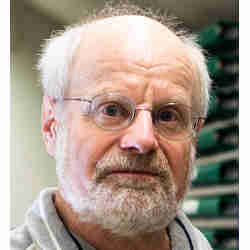
Introduction
The history of computer science in Switzerland begins with the founding of the Institute for Applied Mathematics at ETH Zurich. In order to acquire "in-depth knowledge of modern electrical and electronic calculating machines and differential analyzers" and "to study the newer methods of applied mathematics on the spot", a working group traveled to the U.S. in October 1948. It consisted of the head of the institute, Eduard Stiefel, the mathematician Heinz Rutishauser and the electrical engineer Ambros Speiser.
The stay began with training at the Watson Laboratory for Scientific Computation at Columbia University in New York, where numerical work was carried out on IBM punched card machines. In March 1949 Stiefel returned to Switzerland. At that time Rutishauser was working with John von Neumann at the Institute for Advanced Study in Princeton, where the fastest electronic machine (IAS computer) was built. Speiser worked with Howard Aiken at Harvard University in Cambridge (Massachusetts) on the construction of the large Harvard Mark 3 vacuum tube computer. Stiefel's employees remained in the United States until the end of 1949.
This short report is limited to the description of Stiefel's study visit.
New York
Stiefel spent seven weeks in New York and worked at the following institutions:
- Watson Laboratory for Scientific Computation, Columbia University (Wallace Eckert). Here IBM machines, hand-operated machines (desk calculators) and an electrical analog device were available. Numerical calculations were carried out on the large SSEC electronic computer (completed in 1948) in IBM's main building.
- Institute for Mathematics and Mechanics, University of New York. This institute used hand calculating machines at that time.
- Computation Laboratory of the National Bureau of Standards. The equipment consisted of hand calculators and IBM machines.
Washington, D.C.
Stiefel spent two weeks in the U.S. capital. He worked in two institutions:
- Office of Naval Research. IBM machines and a large relay machine were used. The Era electronic computer (completed in 1950) was under construction.
- National Bureau of Standards. Stiefel visited the Machine Development Laboratory.
Cambridge, Massachusetts
For three weeks Stiefel worked near Boston:
- Harvard University, Cambridge (Howard Aiken). The Harvard Mark 3 (1950) vacuum tube computer was built here. The relay computer Harvard Mark 1/IBM ASCC (1944) calculated seven days around the clock. In Cambridge there was also a discussion about a planned European computing center of the UNESCO. Ambros Speiser stayed in Cambridge for several months.
- Massachusetts Institute of Technology, Cambridge. The MIT demonstrated a large mechanical differential analyzer and a smaller electrical integrating instrument to Stiefel. The secret Whirlwind (1951) electronic computer was in development. Vannevar Bush had built analog differential analyzers (1930/31 and 1942).
Princeton, New Jersey
Stiefel spent two weeks in Princeton. Albert Einstein was there, too.
- Institute for Advanced Study (John von Neumann). The fast IAS (1952) digital computer was under construction. Heinz Rutishauser stayed here for several months.
Visits
Stiefel visited the following facilities for one day each:
- Aberdeen (Maryland), Ballistic Research Laboratory (Army). The huge Eniac (1946) vacuum tube computer and a Bell relay computer were located here.
- Dahlgreen (Virginia), Naval Proving Ground (Navy). The Harvard Mark 2 (1947) relay computer was used on this test site.
- Philadelphia (Pennsylvania). At the Moore School of Electrical Engineering the Edvac (1952) vacuum tube computer was under construction. The Eckert-Mauchly Computer Corporation (later Remington Rand) built the electronic computers Binac (1949) and Univac (1951).
- Waltham (Massachusetts). Raytheon developed an electronic machine.
- Poughkeepsie (New York). IBM built the IBM 701 (1952) electronic computer.
Concluding remarks
Due to his stay in the U.S., Stiefel came to the following intention: self-construction of a reliable relay machine based on Aiken's model and use of IBM punched card machines as an interim solution during construction. However, The Ermeth (1956) vacuum tube computer was built. And from 1950 to 1955, the ETH had rented the Z4 relay computer from Konrad Zuse.
At the beginning of May 1949, Stiefel obviously had no knowledge of the Zuse machine, which was in Bavaria at that time. To this day, we do not know how ETH Zurich learned about the relay computer then called V4. In the meeting of 25 June 1949, the Calculating machine commission, set up in December 1947, instructed its chairman, Eduard Stiefel, to inspect the machine in Hopferau near Füssen. Stiefel visited Zuse in Bavaria on July 13, 1949.
The knowledge gained in the U.S. led to the following book: Heinz Rutishauser; Ambros Paul Speiser; Eduard Stiefel: Programmgesteuerte digitale Rechengeräte (elektronische Rechenmaschinen), Birkhäuser Verlag, Basel 1951, 102 pages. This was the leading publication on computer construction at the time, along with Engineering Research Associates, Inc.: High-speed computing devices, To-mash Publishers, Los Angeles, San Francisco 1983, xlii, 451 pages (first published in 1950).
References
Bruderer, Herbert: Meilensteine der Rechentechnik, De Gruyter Oldenbourg, Berlin/Boston, 3rd edition 2020, volume 1, 970 pages, 577 illustrations, 114 tables, https://www.degruyter.com/view/title/567028?rskey=xoRERF&result=7
Bruderer, Herbert: Meilensteine der Rechentechnik, De Gruyter Oldenbourg, Berlin/Boston, 3rd edition 2020, volume 2, 1,055 pages, 138 illustrations, 37 tables, https://www.degruyter.com/view/title/567221?rskey=A8Y4Gb&result=4
Bruderer, Herbert: Milestones in Analog and Digital Computing, Springer Nature Switzerland AG, Cham, 3rd edition 2020, 2 volumes, 2,000 pages, 715 illustrations, 151 tables, https://www.springer.com/de/book/9783030409739
Stiefel, Eduard: Bericht über eine Studienreise nach den vereinigten Staaten von Amerika. 18. Oktober 1948 bis 12. März 1919, Zürich, 6. Mai 1949, 8 pages (ETH-Bibliothek, University Archives, SR3:1949, 232.143-232.144, 622+)
Herbert Bruderer is a retired lecturer in didactics of computer science at ETH Zürich. More recently, he has been an historian of technology. bruderer@retired.ethz.ch, herbert.bruderer@bluewin.



Join the Discussion (0)
Become a Member or Sign In to Post a Comment